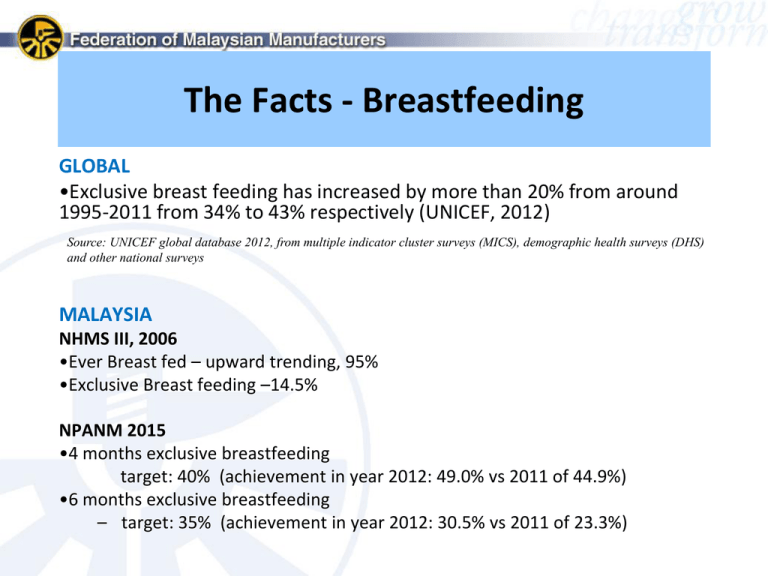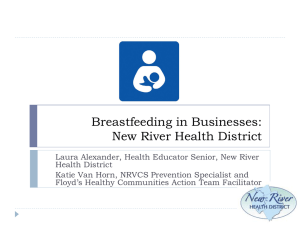COE Revision-data slides
advertisement

The Facts - Breastfeeding GLOBAL •Exclusive breast feeding has increased by more than 20% from around 1995-2011 from 34% to 43% respectively (UNICEF, 2012) Source: UNICEF global database 2012, from multiple indicator cluster surveys (MICS), demographic health surveys (DHS) and other national surveys MALAYSIA NHMS III, 2006 •Ever Breast fed – upward trending, 95% •Exclusive Breast feeding –14.5% NPANM 2015 •4 months exclusive breastfeeding target: 40% (achievement in year 2012: 49.0% vs 2011 of 44.9%) •6 months exclusive breastfeeding – target: 35% (achievement in year 2012: 30.5% vs 2011 of 23.3%) The Facts - Breastfeeding • WHO recommendation if breastfeeding is not possible – wet-nursing or a human milk bank – Home-prepared formula with micronutrient supplements – Infant formulas based on Codex standards Percentage The Facts - Breastfeeding The Facts - Breastfeeding Source: Adapted from presentation – 1st COE Revision, 24th Feb 2014, & NHMSIII, 2006 The Facts - Breastfeeding • Some of the factors based on 7 independent research papers from Malaysia – – – – – – Inadequate health education Work Insufficient milk late initiation of breastfeeding breastfeeding difficulties breastmilk expression • Other factors based on 7 independent research papers from other countries – lack of knowledge, support and help with BF difficulties. – breastfeeding breaks are not available – quality infant care near her workplace is inaccessible or unaffordable – no facilities are available for pumping or storing milk Research has not shown that marketing of FMPC or pregnant/lactating milk products affects breastfeeding rate in Malaysia The Facts - Breastfeeding No 1 2 3 4 5 6 Reference paper (details of paper incl author, title of study, journal, volume and Factors impacting breastfeeding according to paper year) Tan KL. Knowledge, attitute and practice on factors associated with not practicing exclusive breastfeeding were breastfeeding in Klang, Malaysia. The International Medical Journal. 2009; 8 (1): mothers’ ethnicity, working status, household income and infant gender. 17-21 Breastfeeding was associated with mothers delivering in government hospitals and with good knowledge of breastfeeding. Continued Tan KL. Breastfeeding practice in Klang District. Malaysian Journal of Public Health promotional efforts targeted at private hospitals with information on breastfeeding should result in further increase in breastfeeding prevalence. Medicine 2007; 7(2): 10-14 Osman A & Md Isa Z. Nutritional status of woman & children in Malaysian rural populations. Asia Pacific Journal of Clinical Nutrition. 1995, 4 : 319-324 Sellapan M & Shamsuddin K. Major factors influencing breastfeeding practice among Indian mothers in estates. Jurnal Kesihatan Masyarakat 1997; 12 (1). Tengku Alina TI et al. Factors Predicting Early Discontinuation of Exclusive Breastfeeding among Women in Kelantan, Malaysia. Health and the Environment Journal 2013; Vol 4 (No.1) Mohd Amin R et al. Work related determinants of breastfeeding discontinuation among employed mothers in Malaysia. International Breastfeeding Journal 2011; 6:4 Tengku Alina TI et al. Breast milk expression among formally employed women in urban and rural Malaysia: A Breastfeeding is still a common practise in rural area. However, inadequate health education tended to reduce the duration of breastfeeding & increased early weaning. Two main reasons given by mothers for not breastfeeding were work and insufficient milk. Discontinuation of exclusive breastfeeding was associated with the late initiation of breastfeeding, breastfeeding difficulties, prenatal intended duration and breastmilk expression. important that workplaces provide adequate breastfeeding facilities such as a room in which to express breast milk and a refrigerator, and allow mothers flexible time to express breast milk. Many women are unable to practice exclusive breastfeeding because they are separated from their infants while working. Expressing their breast milk helps them to continue breastfeeding. More practical and focused education, as well as provision of facilities, is needed for women to effectively and safely express and store their breast milk. The issue of inadequate milk production should be emphasized, especially by Remarks Malaysian study Malaysian study Malaysian study Malaysian study Malaysian study Malaysian study Malaysian study Why the need for FMPC? • • • • • • Supplement the nutritional needs of children from the age of 1-9 years FMPC products comply with the FMPC Standard (Regulation 91B of the Food Act & Regulations 1985) Formulated to help meet the nutritional needs of children based on recommendations of the Malaysian Recommended Nutrient Intake (MRNI) guidelines to provide at least 1/3 of MRNI for children Milk products are good sources of calcium and several other nutrients such as protein, vitamin A, vitamin B1, B6 & B12, magnesium, phosphorus and zinc. Milk products is also one of the most nutrient dense foods and is recommended by the Malaysian Food Guide Pyramid. The structure/composition of FMPC is also amenable to taste innovation, able to take on the addition of functional ingredients and able to act as a carrier for mandatory/required nutrients for this population. The Facts – Nutrition Status of Children Children 1 to 3 years of age are the most susceptible to undernutrition, children 4 to 6 years are at higher risk of being overweight Key recommendation by Malaysian Dietary Guideline to consume milk and milk products 2-3 servings daily Malaysia: Nutritional Intervention Plan needed • Studies have shown that: – More than 1/3 of children (aged 6 months to 12 years) did not achieve the Malaysian RNI for energy, Ca and vitamin D (Poh BK et al, 2013) – Significant decrease in Ca intake vs RNI in children (4-6 years) from both rural and urban areas (Abdul Aziz MF & Naleena Devi N, 2012) – Mean HAZ (height-for-age) and WAZ (weight-for-age) status was least satisfactory after about 6 months, suggesting a faltering in growth rate at an age that coincides with dependence on complementary feeding (Khor GL et al, 2009) Source: Poh BK et al, 2013. Nutritional status and dietary intakes of children aged 6 months to 12 years: findings of the Nutrition Survey of Malaysian Children (SEANUTS Malaysia), British Journal of Nutrition (2013), 110, S21–S35 Abdul Aziz MF & Naleena Devi. Nutritional status and eating practices among children aged 4-6 years old in selected urban & rural kindergarten in Selangor, Malaysia 2012; 4(4): 116-131 Khor GL et al, 2009. Nutritional Status of Children below Five Years in Malaysia: Anthropometric Analyses from the Third National Health and Morbidity Survey III (NHMS, 2006), Mal J Nutrition 15(2):121-136, 2009 Preferred Choice of Drinks Among Children Aged 11 Chocolate malt drink Blackcurrant concentrate Source: Babolian H.R and Karim A, MS . Factors affecting milk consumption among school children in urban and rural areas of Selangor, Malaysia. International Food Research Journal 17:651-660 (2010) Phillipines case studies The National Nutrition Survey Data collected regularly between 2005 and 2011 by the Food and Nutrition Research Institute (FNRI), provides a clear picture of the effect of this regulation. •Overall Nutritional Impact, 2005-2011 as a result of the Revised Milk Code Underweight malnutrition did not change (20.2%) Stunting increased .5%, (33.1% to 33.6%) Wasting increased 1.5% (5.8% to 7.3%) Overweight malnutrition increased 1.8%(2.5% to 4.3%) Why the need for Maternal milk formulations? (1) • Maternal milk formulations are dietary milk supplements for pregnant and lactating women and are intended to meet their nutritional needs, and are not related to infant feeding. • Maternal milk plays an important role in supplementing the diet of pregnant and lactating women, so that they receive adequate nutrition to provide for their own needs during pregnancy and lactation, and to support the growth of the fetus. • Furthermore, maternal malnutrition is a key contributor to poor fetal growth, low birth weight (LBW) and infant morbidity and mortality and can cause long-term, irreversible and detrimental cognitive, motor and health impairments (Abu-Saad K & Fraser D, 2010; Victoria CG et al, 2008; Kanade AN et al, 2008) Source: Abu-Saad K and Fraser D, 2010. Maternal Nutrition and Birth Outcomes. Epidemiol Rev 2010;32:5–25 Victoria CG et al, Maternal and child undernutrition: consequences for adult health and human capital. Lancet 2008; 371: 340–57 Kanade AN et al, 2008. Maternal Nutrition and Birth Size among Urban Affluent and Rural Women in India. Journal of the American College of Nutrition, Vol. 27, No. 1, 137–145 (2008) Why the need for Maternal milk formulations? (2) • Allen, L. SCN News. 1994; (11):21-4. Maternal Micronutrient Malnutrition: Effects on Breast Milk and Infant Nutrition, and Priorities for Intervention – From a global perspective, lactating women are more likely to suffer from micronutrient deficiencies than from a shortage of dietary energy or protein – Also, micronutrient deficiencies are more likely to affect breastmilk composition, and the development and nutritional status of the infant – Dietary interventions or supplementation can increase the secretion of many of these nutrients in breast milk, and improve infant nutritional status – Suggested Priorities for Maternal Micronutrient Supplementation During Lactation • Thiamin, Riboflavin, Vitamin B-6, Vitamin B-12, Vitamin A, Vitamin D • Iodine, Selenium, Folic acid, Calcium, Iron, Copper, Zinc Source: Allen L. Maternal Micronutrient Malnutrition: Effects on Breast Milk and Infant Nutrition, and Priorities for Intervention. SCN News 1994; 11: 21-4




